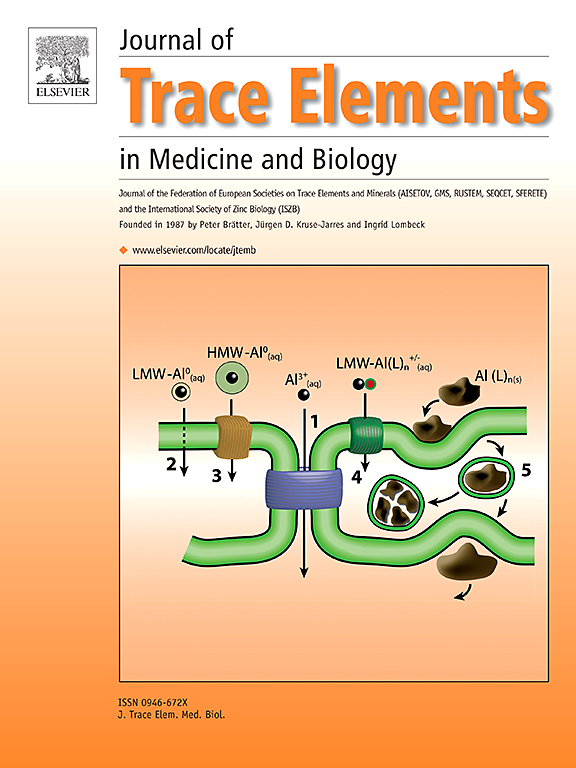Selenium exposure and risk of skin cancer: A systematic review and dose-response meta-analysis of epidemiologic evidence
IF 3.6
3区 医学
Q2 BIOCHEMISTRY & MOLECULAR BIOLOGY
Journal of Trace Elements in Medicine and Biology
Pub Date : 2025-07-07
DOI:10.1016/j.jtemb.2025.127693
引用次数: 0
Abstract
Background
Controversies still exist about the effects of selenium exposure on skin cancer risk.
Methods
We performed a systematic literature search of non-experimental and experimental studies investigating the relation between selenium and risk of melanoma and non-melanoma skin cancers (NMSC) in adults.
Results
We identified 26 studies, 19 of which were suitable for quantitative meta-analysis. In non-experimental studies, serum/plasma selenium concentrations showed slightly lower risk of NMSC, while no change in risk was observed for toenail or dietary selenium. Dose-response meta-analysis showed a general decreasing NMSC risk with increasing selenium serum/plasma concentrations, while there was no change in risk at any level of toenail selenium concentration. In experimental studies, we observed a higher risk for squamous cell carcinoma (risk ratio 1.25, 95 % confidence interval 1.04–1.49), but not basal cell carcinoma or NMSC overall in selenium-supplemented participants. In dose-response analysis of non-experimental studies, we observed little association between selenium exposure and melanoma risk, with limited evidence of increased risk for low (<100 µg/L) serum selenium. Using toenail concentrations, we found an inverted U-shaped pattern, with a lower melanoma risk at both low and high selenium concentrations, likely due to differences in risk across cohort and case-control studies showing positive and null associations, respectively. An excess risk following environmental selenium exposure through drinking water was noted. In experimental studies, selenium supplementation was associated with higher but imprecise melanoma risk (risk ratio 1.24, 95 % confidence interval 0.57–2.68).
Conclusion
Overall, selenium exposure does not appear to influence basal cell carcinoma risk, but is associated with increased risk of squamous cell carcinoma and potentially melanoma.
硒暴露与皮肤癌风险:流行病学证据的系统回顾和剂量反应荟萃分析
硒暴露对皮肤癌风险的影响仍存在争议。方法系统检索非实验和实验研究的文献,探讨硒与成人黑色素瘤和非黑色素瘤皮肤癌(NMSC)风险的关系。结果共纳入26项研究,其中19项适合进行定量荟萃分析。在非实验研究中,血清/血浆硒浓度显示NMSC的风险略低,而脚趾甲或膳食硒的风险没有变化。剂量-反应荟萃分析显示,随着血清/血浆硒浓度的增加,NMSC风险普遍降低,而在任何水平的趾甲硒浓度下,风险都没有变化。在实验研究中,我们观察到补充硒的参与者患鳞状细胞癌的风险更高(风险比为1.25,95 %置信区间为1.04-1.49),但总体上没有基底细胞癌或NMSC。在非实验研究的剂量反应分析中,我们观察到硒暴露与黑色素瘤风险之间几乎没有关联,只有有限的证据表明低(<100 µg/L)血清硒会增加风险。使用脚趾甲浓度,我们发现了倒u形模式,低硒和高硒浓度下黑色素瘤风险较低,可能是由于队列研究和病例对照研究的风险差异,分别显示出正相关和零相关。注意到通过饮用水接触环境硒的过量风险。在实验研究中,硒补充与更高但不精确的黑色素瘤风险相关(风险比1.24,95 %置信区间0.57-2.68)。总的来说,硒暴露似乎不会影响基底细胞癌的风险,但与鳞状细胞癌和潜在黑色素瘤的风险增加有关。
本文章由计算机程序翻译,如有差异,请以英文原文为准。
求助全文
约1分钟内获得全文
求助全文
来源期刊
CiteScore
6.60
自引率
2.90%
发文量
202
审稿时长
85 days
期刊介绍:
The journal provides the reader with a thorough description of theoretical and applied aspects of trace elements in medicine and biology and is devoted to the advancement of scientific knowledge about trace elements and trace element species. Trace elements play essential roles in the maintenance of physiological processes. During the last decades there has been a great deal of scientific investigation about the function and binding of trace elements. The Journal of Trace Elements in Medicine and Biology focuses on the description and dissemination of scientific results concerning the role of trace elements with respect to their mode of action in health and disease and nutritional importance. Progress in the knowledge of the biological role of trace elements depends, however, on advances in trace elements chemistry. Thus the Journal of Trace Elements in Medicine and Biology will include only those papers that base their results on proven analytical methods.
Also, we only publish those articles in which the quality assurance regarding the execution of experiments and achievement of results is guaranteed.

 求助内容:
求助内容: 应助结果提醒方式:
应助结果提醒方式:


